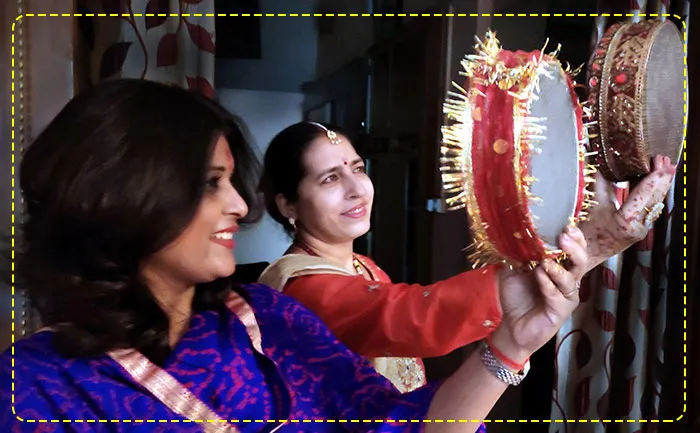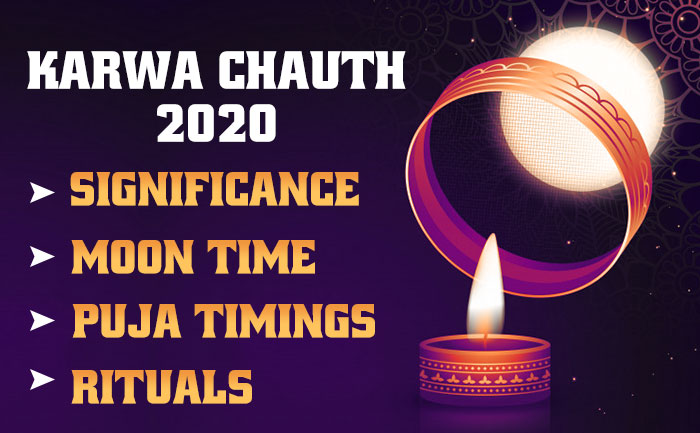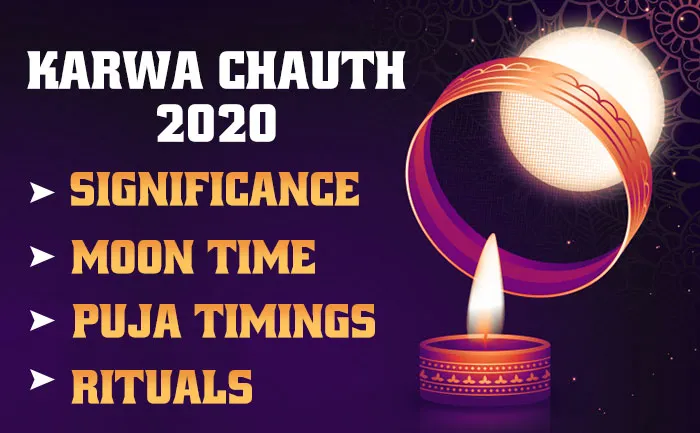India is also known as the land of Festivals. We love to celebrate and have a festival for most of the occasions. They help us bond with our family and friends. One of the most significant festivals celebrated in North India is of Karva Chauth. On this day married women keep a day-long fast to pray for the well-being of their husband, and break it only after sighting the Moon at night.


Karwa Chauth, traditionally known as Karak Chaturthi falls on the fourth day after the full moon (Purnima), which is Krishna Paksha Chaturthi in the month of Kartik. On the day of Karak Chaturthi, women pray to Maa Parvati, who epitomises Akhand Saumbhagyavati. Devotees also hail the Mother Goddess as Karak Mata or Chauth Mata in some regions.
Karva Chauth is also referred to as ‘Karak Chaturthi’ in some places. ‘Karva’ or ‘Karak’ in Hindi means ‘a pot’ while ‘Chauth’ implies ‘fourth day’. This earthen pot is then used to make water offerings to the moon. The Karva also called as ‘Argha’ is considered very auspicious and given away to the elderly woman in the family or to the Brahmin as ‘Dan’ after the puja.
Karwa Chauth 2020: Here is all you need to know about Karwa Chauth:
Date and Muhurat:
Karwa Chauth festival is widely celebrated by married women of India and most commonly celebrated in Northern India. It falls 4 days after the full moon day (Sharad Purnima). In 2020 Karwa Chauth falls on Wednesday, 4 November; which is the Krishna Paksha Chaturthi in the Hindu month of Kartik.
Karwa Chauth 2020 Chaturthi Tithi:
The Chaturthi Tithi begins at 3:24 AM on November 4 and ends at 5:14 AM on November 5.
Karwa Chauth 2020 Upavas time:
Karwa Chauth 2020 Upvas timings are between 6:35 AM to 8:12 PM.
Karwa Chauth 2020 Puja muhurat:
The Karwa Chauth puja muhurat is between 5:34 PM to 6:52 PM
Karwa Chauth 2020 Moonrise Timing:
The Moon will rise at 8:12 PM.
Legend:
A popular legend around this festival is about Veervati and her brothers. As per the legend, Veervati was the only sister among seven brothers who loved her the most. On her first Karwa Chauth, she celebrated the day at her family’s home. Her brothers were unable to see her hungry and thirsty and tricked her with a mirror in a pipal tree that made it look like the moon had risen. Veervati mistook it for the moon and broke her fast. She received a message she got the message of her husband’s death from her servants. Heartbroken, she wept all night long until a goddess appeared in front of her and asked her about her misery. The goddess asked her to observe the Karwa Chauth fast again with dedication and devotion to see her husband alive. Veervati followed her instructions and observed a fast again. Impressed with her dedication, Yama, the god of death, was forced to bring her husband back to life.
Rituals of the Karva Chauth Vrat:
Karva Chauth Vrat is observed by both married and unmarried women. The women observe this fast without eating or drinking anything till the time they see the moon. Mehndi is applied as it is a symbol of good fortune for married women. Married women receive beautiful and expensive gifts from their husbands and in-laws. The gifts can be anything from bangles, jewellery, henna, lehenga choli, sarees and other traditional gifts.
Women get up before sunrise and eat the food that is especially prepared, known as ‘Sargi’. They will not have even a drop of water after this till they see the moon at night.
What is Sargi?
It is the pre-dawn meal that comes from the mother-in-law before the daughter-in-law starts her fasting. It contains cooked food, dry fruits, sweets, Diya, matri, dahi, etc.
In the evening, all the women observing the Karva Chauth vrat dress up beautifully in their bridal jewellery. Newlywed brides even adorn their bridal costume. On this day, Lord Shiva is worshipped along with Goddess Parvati and their son ‘Kartikeya’.
How is the Pooja Performed:
Women collectively listen to and also sing the Karva Chauth puja song by performing feris (means passing their thalis to one another in the circle) seven times. In the first six feris they sing like: “Veero kudiye Karvara, Sarv suhagan Karvara, Aye katti naya teri naa, Kumbh chrakhra feri naa, Aar pair payeen naa, Ruthda maniyen naa, Suthra jagayeen naa, Ve veero kuriye Karvara, Ve sarv suhagan Karvara” whereas in the seventh feri: “Veero kudiye Karvara, Sarv suhagan Karvara, Aye katti naya teri nee, Kumbh chrakhra feri bhee, Aar pair payeen bhee, Ruthda maniyen bhee, Suthra jagayeen bhee, Ve veero kuriye Karvara, Ve sarv suhagan Karvara”.
After the pooja ceremony, women start waiting for the moon to rise. Once the moon gets visible in the sky all fasting woman go outside with their husband to see the moon. They offer Arghya to the moon to get blessings. Every woman holds a sieve and first looks towards her husband and then at the moon. Following this, they perform aarti of their respective husbands and take their blessings. As a part of the ritual, the husbands give their wives, the first sip of water and a bite of food. After this, all the women observing the Karva Chauth Vrat take the blessings of the elders in their family. The Karva used for ‘argh’ to the moon is then given to an elderly lady or even to a Brahmin as ‘dan’. All the women of the household then collectively gather and together enjoy the scrumptious spread of food prepared.
Do’s and Don’ts:
Karwa Chauth Dos:
- Get up early, take bath and be prepared to fast for the day.
- Talk politely to everyone, especially your family members.
- Wear bright coloured outfits on this day. It is advised to wear red clothes and it is the colour of Suhaag or being married.
- Apply mehndi and have pleasant thoughts throughout the day.
- Break the fast only after looking at the moon through the sieve.
- Check the moon rise timings a night before so you know the time around which you will be able to break your fast.
Karwa Chauth Don’ts;
- Do not use scissors or needles. Use of pointed objects on the day of the festival is inauspicious.
- Do not speak rudely especially with your mother-in-law.
- Do not give anything in the colour of white. Anything that resembles the moon should not be given. So avoid offering rice, milk, curd or white coloured items to anyone.
- Not to wear dark coloured clothes like the shades of blacks, Blue or brown.
- Nor argue with anyone.
- Do not throw bangles, sindoor, bindi, etc in the dustbin. If bangles get cracked while wearing, keep it at the place of puja.
States where it is quite popular:
The festival of Karva Chauth is celebrated with immense fervour and zeal all over India. In the northern states of Rajasthan, Uttar Pradesh, Punjab, Haryana and Himachal Pradesh the festivities are observed on a grander scale. Karva Chauth is celebrated as ‘Chhath’ in the Indian states of Bihar, Jharkhand, Chhattisgarh and Madhya Pradesh.
The occasion of Karva Chauth marks the beginning of festivals in India. Four days after Karwa Chauth, Ahoi Ashtami Vrat too is observed in a similar manner but for the wellbeing of sons.
Also Read: Navratri 2020: 7 things you should AVOID during this festival


